Speargun

Well, the first thing you need to go spearfishing is a reliable and accurate speargun. Unlike your fishing rod, you will never need bait or hooks and it will give you seasons of use as long as you give it a proper rinse with fresh water after every dive. Please refer to this link What size speargun do you need? (spearfishing.co.uk) for more information on Spearguns.
The key features to look out for are:
Grip – needs to be comfortable and steady as you will swim long distances with it.
Barrel – a good length for a beginner is 70-90cm. At the lowest end of the spectrum in terms of cost – you have aluminum barrel guns. For extra precision you may prefer a railgun with an integrated rail for accuracy. In our opinion, rail is the main feature which sets the good guns out from the cheaper alternatives and gives you a fantastic platform which can be upgraded in the future. A basic inexpensive railgun we highly recommend is the Rob Allen Cobia (Rob Allen Cobia Beginners Speargun – Spearfishing UK). For those wanting the maximum in handling and accuracy we have carbon railed barrels, all of which are available in all lengths by the majority of the brands we stock. One of the Rob Allen versions specifically is the GT Carbon (Rob Allen GT Carbon Speargun – Spearfishing UK).
Wooden guns are also available however these tend to be a little pricier for good reason! Wood is a fantastic material for building spearguns as it naturally floats and can be ballasted to be neutrally buoyant making it far more agile and nimble in the water than aluminum or carbon counterparts. Despite the gun being neutrally buoyant and feeling light when submerged, the wood is actually very heavy and has a lot of mass which allows the speargun to absorb a lot of the reoil, in turn, making it a lot more accurate. Often hard words are used including Teak, Iroko, Mahogany and Koah, often requiring a layer of Epoxy to seal them (with the exception of Teak). They are very desirable and can look incredible. This is true for the handmade Riffe guns we stock, which interestingly, are also silent when fired! Riffe guns can be found here: Guns – Spearfishing UK
Muzzle – holds the bands and shaft in place. An open muzzle is our default option and is excellent for aiming as there’s usually an unrestricted field of view in this design. Some divers prefer an open muzzle and others prefer a closed – one is no better than the other and the choice of either usually comes down to personal preference. Brands are currently shying away from the older style closed muzzle with many of the models we stock choosing the open design. Many brands, including Rob Allen, have designed both Open and Closed muzzles which are easily swapped out on their guns if there is a personal preference.
Bands – Where to start with bands? There are MANY styles and configurations to choose from… The classic style is the straight screw in bands, or double screw in, the standard for the Salvimar Wild Pro (Salvimar Wild Pro Speargun – Spearfishing UK). This has largely been phased out for the more popular and often more powerful circular band as the later tends to be more expensive to replace, is more prone to failure on the screw in threads, and also utilizes less rubber and therefore isn’t as powerful as the circular alternative. The Salvimar V-pro mono has a single circular band for reference (Salvimar V-Pro MONO RAIL Speargun – Spearfishing UK). In essence, the closed circular band is a length of rubber closed off with a dyneema, or metal wishbone (the piece that attaches to the notches on the spear when loaded).
Some people will even opt for a roller band or roller gun (Rob Allen GT Carbon Roller Speargun – Spearfishing UK) — this style is largely seen as being the bread and butter for big game spearfishermen, however it has become increasingly popular in the UK on smaller guns for more casual fishing. Because as the band is pre-tensioned when unloaded, it is capable of propelling the spear all the way to the end of the muzzle (whereby circular and straight bands will not), essentially giving you a longer gun in a smaller package. A 90 Rob Allen Roller with a 16mm bands will act much like a 110 Rob Allen Tuna (with twin 16mm bands) for example. Some brands like Pathos will use this Roller system in conjunction with a circular band like in the Laser Roller Carbon (Pathos Laser Carbon Roller Speargun – Spearfishing UK) — sometimes comically referred to as a ‘Roller and a half.’ You can even get Inverted or Invert’ Rollers, which pre-tension the bands further, greatly increasing the power again. The Picasso Magnum BW Invert Roller is a good example which utilizes this band set up (Picasso Magnum BW Invert Roller – Spearfishing UK). Although this may seem a little overkill for poor Mullet or Bass, many of the top Spearos in the UK will opt for the Invert Roller set up as their go-to gun. At the end of the day, there’s no such thing as being ‘overpowered,’ – it’s often just a lot more fun!
14mm -20mm bands are available. 20mm are the most powerful but a single 16mm band will be fine for most UK spearfishing, twin 14mm circular bands are more popular for those seeking a little more ‘playable’ range and power. You’re only ever going to be able to shoot as far as your line allows, so for thicker/more powerful bands, some Spearos like to rig their gun with a double (or even triple) wrap of dyneema or monofilament shooting line allowing them to use all of the available range of the gun. This could be the difference between coming back with the pesky big Bass that wanted to sit at the edge of the vis or having to admit to the family they’re not having the meal you promised! It must be noted there is a small playoff — adding more bands will create more hydrodynamic drag; Although this will be minimal, it is often noticeable…
A set of bands should last you a full dive season – Rob Allen rubber specifically has proven to last for nearly 3! (Rob Allen Rubber Bands- Blue Reactive – Spearfishing UK). For longer life do not store them exposed to sunlight. Some divers even store them in the fridge if the gun is not to be used for a while! In terms of compounds: extruded rubbers like those supplied as standard on cheaper guns tends to weep, crack and perish at a far quicker rate than the dipped alternative which has a UV protective coating. For this reason, we always recommend spending the extra and going for a dipped rubber (it tends to be cheaper in the long run as it lasts a lot longer and due to its superior performance).
We stock a large range of Rubber bands – from the cheapest, least powerful extruded pre-made Cressi bands (Cressi 16mm Circular Rubber – Spearfishing UK), all the way up to the most popular and hardest hitting dipped bands like Pathos Nitro (Pathos Nitro rubber Bands- Reactive – Spearfishing UK). We also have Reactive and Progressive rubbers to choose from: to keep it simple, reactive is punchy and linear, whereas Progressive rubber will tend to have a smoother and accelerated power delivery. They both output the same level of power, but just act in a different way.
View our range of spearguns / Download our PDF speargun buyer’s guide
 Shaft
Shaft
For a single 16mm band a 6mm to 6.75mm spear will be sufficient, but a thicker spear will be more accurate but will fire slower. For a thicker single band 17mm up to 20mm a 6.3mm to 7mm will be sufficient. A great middle ground for the UK is twin 14mm bands as they are quick and easy to load but give you more range and power than a single band without too much added weight and drag. An ideal spear for this setup is from 6.5mm to 7mm.
If you’re wanting ultimate power and range twin 16mm bands is the most popular, a spear from 6.75 to 7.5mm is ideal for this scenario. Some guns such as the Pathos Laser Open Carbon use twin 17.5mm bands, for a setup this powerful you want a spear no thinner than 7mm.
For roller guns, typically a 16mm band roller gun will have a spear around 7mm but this varies depending on the model.
Spear material is also a big consideration when choosing a spear – Pathos Sandvik steel spears will blunt quicker than Rob Allen Carbon Steel (i.e., spring steel) Spears, but they are far more rust resistant than the heavier, harder counterparts. There are varying grades of Stainless Steel (sandvik being one of the best), most beginner to intermediate guns will come with very basic Stainless-Steel spears which are easy and cheap to replace but will be easily damaged/bent. It may be worth considering buying a better spear (Rob Allen or Pathos), if you want to take your gun to the next level!
If you accidentally hit a rock, you can sharpen the spear easily with a rasp file. Make sure you wash the spear in fresh water after every dive and keep it out of the gun when being stored. This will reduce the chance of corrosion. Should your shaft get bent, for example by a conger eel, although it can be more or less straightened by bending it back across your knee, we would advise a replacement shaft to ensure your accuracy is not affected. It is very unusual for a shaft to get bent in the first place in the UK except with congers.
If you have any queries regarding spear sizes or thicknesses, please don’t hesitate to get in touch! We’re more than happy to talk you through the specifics!
Floats
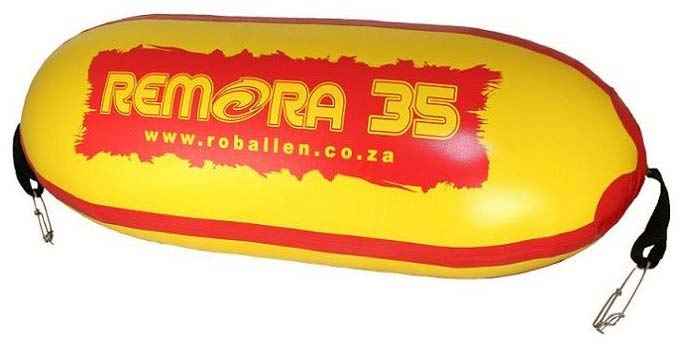
You need a float at all times when diving in the UK. The primary function is to warn boat users of your presence, and to show your position should you get into difficulties. The other function is that it will stop you ever losing your speargun. Your speargun connects to your float via the floatline, so if it every gets dropped, or gets stuck after you shoot a fish in a crack on the bottom, you can always find your gun again.
Floats come in many different shapes and styles, from Round Buoys (Epsealon Round Buoy with internal bladder – Spearfishing UK), to Torpedo’s (Salvimar Double Torpedo Boa Siluro Float – Spearfishing UK), Flat Boards (Picasso Hydro Float | Spearfishing UK) which often allow you to strap drinks and other items onto the float for long excursions, or even Boats (Epsealon Patrol – Spearfishing UK) for when you need to push far offshore to hit distant pinnacles.
We also stock a large range of pressurized floats for the bigger fish. The Remora floats by Rob Allen (Rob Allen float (spearfishing.co.uk), are very popular for blue water spearfishing when strung to the end of a breakaway system but can also make a fanatic, strong UK shore diving float with minimal drag. We also stock the Rob Allen hard float (Rob Allen hard float – Spearfishing UK) which won’t implode at depth when dunked among other blue water specific kit!
View our range of spearfishing floats
Float Line
The float line attaches at the handle of the gun to the float, most commonly using a Tuna clip (Rob Allen Tuna Clip x 2 – Spearfishing UK). As explained previously, we always recommend having a float attached to your gun as a safety precaution to mark your presence for watercraft as well as acting as a visual aid for the Coastguard/RNLI if in distress — it may very well save your life! Furthermore, having the float attached via a float line allows you to drop your gun at a moment’s notice if required, and won’t mean watching in horror as your pride and joy slowly sinks into the dark abyss never to be seen again; You’ll simply be able to pull your beloved gun back to the surface!
For UK conditions we suggest 10m extra over your usual diving depth. For most intermediate divers a 20m float line is ideal.
Our lines are very strong and resist abrasion. Many also float in the water and have very minimal drag.
Wetsuit
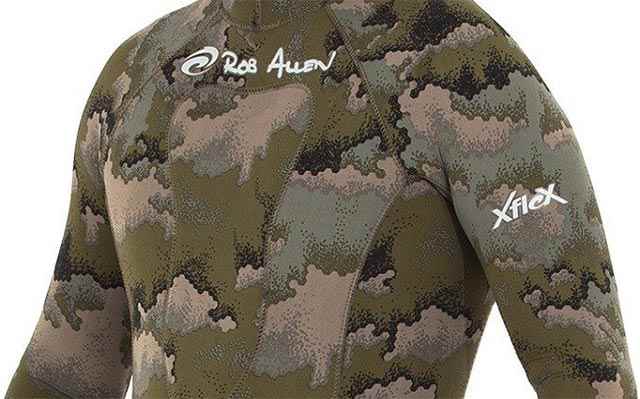
For the UK you will need a 5mm wetsuit to dive through most of the year. Camouflage is a matter of preference, but it is important not to wear anything too brightly coloured. Most spearos in the UK use camo suits now, but some still prefer the traditional black. Make sure you put hot water mixed with shampoo or hair conditioner or a wetsuit lubricant such as Octacle or Slippy wetsuit lube down the suit before putting it on; spearfishing suits need to be wet to put on, but are more comfortable and warmer because of this sticky ‘open cell’ lining.
What is a spearfishing wetsuit?
A typical spearfishing suit will consist of two parts, the trousers and the jacket (Salvimar Krypsis 101 Full Two Piece Wetsuit – Spearfishing UK). These also come in various configurations like with trousers that finish at the waist or have shoulder straps with the main torso also being covered (called long Johns) Picasso Camo Ghost Wetsuit Farmer John Trousers – Spearfishing UK. You can also get one-piece versions, but these are not so popular hence our limited stock of this style.
In the UK we normally use a hooded jacket with trousers, but long johns may also be considered for added warmth, as it doubles the amount of neoprene over your core. This keeps you much warmer for longer. 5mm is the preferred/go-to thickness for the UK spearo and will generally be warm enough for the entire year. However, for the winter months or spearfishing further north, a 7mm full wetsuit or top should be considered. Another cheap option for keeping warm in the winter months is using a neoprene vest under the top (Epsealon Black Under Vest 2.5mm – Spearfishing UK).
In slightly warmer climates where they can get away with it, Spearos will often tend to use thinner (3mm) two-piece suits (most brands/models of suit will have 3mm wetsuit option even if they are not explicitly listed on the site). In warmer water still, during the summer months in the Caribbean for example, you’ll often see spearfishermen in rash-vests and shorts…
Finding the best fit
Much like with masks, the best wetsuit is always the one that fits. This must be the first consideration before anything else, as an ill-fitting wetsuit won’t function as it should! Any bagginess under the arms for example will cause water to pool making you cold. All off the shelf suit branded suits are pre-made to accommodate a certain body type/shape. This varies between the brands whereby for example Salvimar will fit a slimmer taller build, whereas Moray will fit a larger, broader build – it’s not standardized like in surfing. Sadly, this can restrict a lot of people to certain brands.
To find the best suit for you, first you must take measurements for Height, Weight, Chest and Waist. Compare these for the size guides included in the product images on the website. If you’re within the margins you’re looking at a good fit. If your tall and slim look at Salvimar, Pathos and Epsealon. For an average build look at Cressi – they are more of a square cut and the neck is often a complaint as being too large. If you have broader shoulders or are more of a muscly or stockier build, browse at Moray, Jak Boeno and Picasso. All our suits can be found here: Wetsuits – Spearfishing UK
View our spearfishing wetsuits / Download our PDF Wetsuit buyer’s guide
Gloves
You need gloves which will not impair your dexterity. 3mm neoprene are ideal. Gloves will need replacing more often than most items of kit due to the effects of grabbing barnacled rocks and spiny fish!
Boots & Socks
5mm socks are the warmest, but 3mm are fine for summer. Check the fit with your fins, it is best to order your fins a size bigger than usual if you want to use 5mm socks.
Freedive Fins
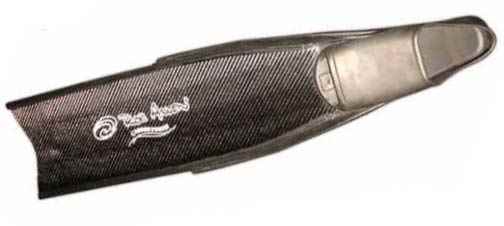
The best and most powerful freedive fins are those which are made of composite materials – Carbon and Inngera being the most efficient. These materials are exceptionally good for deep diving and swimming long distances. Most divers begin the sport with plastic fins which are very durable, and fine for surface swimming and diving to medium depths (10-15m). When divers start to look for game deeper, they will usually move onto a more advanced Fiberglass, Carbon or Inngera fins like those offered by Dive R, Pathos, or XT for example.
Fins for freediving are divided and categorised by the materials their made of. Each material has its own pro/con and in many ways shouldn’t be seen as better or worse than any other.
Plastic — At the cheapest end of the spectrum, you have plastic fins. These are naturally favored by people getting into the sport, as well as spearos who tend to spend a lot of time around rocks. Plastic fins are often the most durable and can take an absolute beating however they aren’t the most efficient leading to an increased risk of cramping and fatigue during longer sessions. Our range varies from £51-£134 with the Rob Allen Scorpia being the most popular at £71.99: Spearfishing UK | Rob Allen’s Scorpia freediving fins.
Fiberglass fins are largely considered the intermediate level. These are much more efficient than plastic fins, and they are also very durable. This is especially true for the RUKU fins Ruku Blades Blue Camo – Spearfishing UK which we have witnessed surviving being driven over by a land rover. Fiberglass fins range from £119.98 (including pockets — Leaderfins Blue Camo Spearfishing Fins – Spearfishing UK), to £247.99 (without pockets — Ruku Blades Tim Li Crayfish – Spearfishing UK). We suggest Fiberglass if you want a fin that can take a beating, but require increased efficiency for repetitive deeper diving, or longer swims.
Carbon/Carbon Fiber fins prices also range wildly, but generally sit towards the top end. A cheap set of Carbon Fiber fins from Leaderfins with pockets will set you back £144.98 (Leaderfins Carbon Fibre Spearfishing Fins – Spearfishing UK). At the most expensive end you have the Dive R Carbons which come in at £449.99 (design dependent, without pockets)DiveR Wahoo Spearfishing Fins – Spearfishing UK.
Carbon Fiber fins are a lot more fragile than Fiberglass and Plastic fins comparatively – the most common break is snapping at the blade angle or chipping the tips; however, they make up for this fragility with some of the greatest efficiency of all materials. We will suggest Carbon Fiber if you aim to repeatedly dive to depth (15m+), or commonly swim long distances during your sessions. These are perfect for spots that have a lot of current too. This isn’t to say they won’t be able to take a beating – we just wouldn’t suggest pushing up from the bottom, walking on the blade when entering/exiting the water, or scraping them against rocks etc. Fragility varies in these blades with some laminates/models proving much stronger than others.
Innegra is the fin that will last forever! When an Innegra weave is reinforced with Carbon it results in a fin that can deform far further than other carbon alternatives without failing, making one of the strongest, lightweight, and efficient blades on the market. With this fin you have the indestructibility of the plastic fin paired with the efficiency of Carbon – the best of both worlds. These blades cost £567.99 without pockets (DiveR Blue Innegra Spearfishing Fins – Spearfishing UK), but ultimately means you’re not going to be buying twice!
Spearfishing Masks
A mask with low volume is the best for spearfishing, making equalizations quick, and reducing hydrodynamic drag when diving deeper for extra efficiency. You will notice that the size of spearfishing/freediving masks differ massively from those worn by scuba divers for this reason. Spearfishing masks will also often have a fully opaque or black skirt — this reduces glare from the sun when facing downwards when on the surface and reduces the risk of your vision being impeded.
Above all else, the best mask is always the one that fits – we would always recommend coming to the shop and trying our range so that you can be sure the mask you end up buying won’t leak and ruin your sessions!
View our range of spearfishing masks
Weight belt
The weights belt needs to be either rubber or webbing with a release mechanism you find easy to activate in case you need to drop it in an emergency. Silicone and Rubber come highly recommended from the team as these are the most comfortable and will allow for a far better breathe-up before taking a dive!
Experiment with the right amount of lead for yourself, to get the balance perfect. To get the right amount of lead we would suggest starting 1kg per mm of suit, -1 (i.e. 4kg for a 5mm suit). Add lead in 1kg increments until you have the correct amount. If you start sinking or have to tread water when bottling – you’ve added too much. The waterline on your mask when penciling should be below your eyeline. Selecting the right amount of lead is really tricky, as there are so many factors that come into play i.e. bone density, % body fat, height, weight…
 Stringer
Stringer
You need your stringer on your float to put your catch on. A heavy-duty stringer will not break and is the easiest way to carry your catch when back on land. Do not attach to your belt; it can catch in the seabed or attract the attention of seals and other predators who may want to share your catch! If you are really weary of Seals or want somewhere to keep Shellfish, consider a catch bag that can attach to your float.
Knife
A small, sharp pointed knife with a reliable sheath is needed. Tying a bungee to the knife is a good way to avoid losing it should it come out of its sheath in breakers etc. You will use the knife to kill the catch, stabbing into the top of the head just behind the eyes. Be careful not to cut yourself in the process. The knife is also fundamentally an essential piece of safety equipment. If you find yourself caught in fishing line for example a serrated knife can save your life! Alternatively, consider buying a line cutter (Mac Safety Line Cutter TS05 – Spearfishing UK).

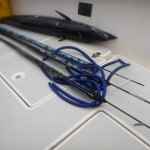 Shaft
Shaft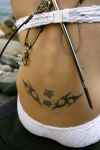 Stringer
Stringer